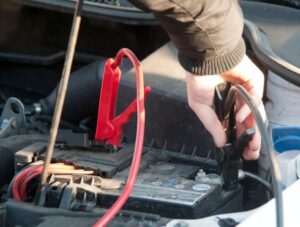Are you stranded with a dead battery and in need of a quick solution? Look no further! In this article, we will guide you on how to charge a dead battery with a charger. Whether you’re dealing with a car battery, a motorcycle battery, or any other type of battery, we’ve got you covered. With our step-by-step instructions and handy tips, you’ll be able to revive your dead battery and get back on the road in no time. So, let’s dive in and learn how to charge a dead battery with a charger!
How to Charge a Dead Battery with a Charger
Introduction
In this article, we will explore the step-by-step process of charging a dead battery using a charger. Whether you have a car, motorcycle, boat, or even a lawn mower, a dead battery can be a frustrating and inconvenient problem. But with the right knowledge and tools, you can easily get your battery back up and running. So, let’s dive in and learn how to charge a dead battery with a charger.
1. Assess the Situation
Before you begin the charging process, it’s important to assess the situation to ensure your safety and the effectiveness of charging. Follow these steps to properly assess the condition of your dead battery:
- Check for signs of physical damage on the battery, such as leaks or cracks. If you notice any damage, it is best to seek professional help.
- Inspect the battery terminals for corrosion. If there is significant corrosion, you may need to clean the terminals before proceeding with charging.
- Ensure the charger you have is compatible with your battery type. Different chargers work with different battery chemistries, such as lead-acid or lithium-ion.
2. Safety Precautions
Working with batteries can be potentially hazardous, so it’s crucial to follow safety precautions. Here are some important steps to ensure your safety during the charging process:
- Wear safety glasses and gloves to protect yourself from any potential acid splashes or electrical shocks.
- Make sure you are working in a well-ventilated area to avoid inhaling toxic fumes that batteries can release during charging.
- Keep any open flames and sparks away from the battery and charger to prevent explosions.
3. Connecting the Charger
Now that you have assessed the situation and taken necessary safety measures, it’s time to connect the charger to the dead battery. Follow these steps for a successful connection:
- Identify the positive (+) and negative (-) terminals on the battery. They are usually marked with red and black, respectively.
- Connect the charger’s positive clamp to the positive terminal of the battery.
- Attach the negative clamp of the charger to the negative terminal of the battery. Double-check your connections at this stage.
4. Selecting the Charging Mode
Most battery chargers come with various charging modes to cater to different battery types and conditions. Here’s how to select the appropriate charging mode:
- Refer to the charger’s manual to understand the charging modes available.
- Choose the mode that matches your battery chemistry and condition. For example, a maintenance mode is suitable for a battery that requires a slow and continuous charge, while a rapid charge mode is ideal for a battery with a low charge but no major issues.
5. Initiating the Charging Process
With the charger connected and the right charging mode selected, you can now initiate the charging process:
- Plug the charger into a power outlet and turn it on.
- Monitor the charging process and ensure that the charger is functioning correctly.
- Some chargers come with built-in features like voltage and temperature monitoring. Take advantage of these features to ensure safe and optimal charging.
6. Charging Time and Maintenance
The charging time can vary depending on the capacity and condition of your battery. It is recommended to refer to the charger’s manual for an estimated charging time. During the charging process, make sure to:
- Regularly check the battery temperature. If it becomes excessively hot, stop the charging process immediately to prevent any damage.
- Keep an eye on the charger’s indicator lights or meter to monitor the progress of the charge.
- Once the battery reaches the desired charge level, disconnect the charger from the power outlet and remove the clamps from the battery terminals.
- Remember to clean the battery terminals and clamps after charging to prevent future corrosion.
7. Testing the Battery
After completing the charging process, it is essential to test the battery to ensure its functionality. You can use a multimeter or take the battery to a professional to perform a load test. Testing the battery helps determine if it can hold a charge and if any further maintenance or replacement is needed.
8. Additional Tips and Considerations
To make your battery charging experience smoother and more effective, here are a few additional tips and considerations:
- If your battery is severely depleted or damaged, it may not be recoverable through charging. In such cases, it is best to consult a professional or consider replacing the battery.
- Always follow the specific instructions provided by the battery charger manufacturer for optimal results and safety.
- Consider investing in a smart charger that provides advanced features like automatic shutoff and maintenance mode, ensuring long-term battery health.
- Regularly inspect and clean your battery terminals and clamps to prevent corrosion, which can hinder the charging process.
Charging a dead battery with a charger is a straightforward process as long as you follow the necessary steps and precautions. By assessing the situation, connecting the charger correctly, selecting the appropriate charging mode, and monitoring the process, you can successfully recharge your dead battery. Remember to always prioritize your safety and refer to the instructions provided by the manufacturer. With proper care and maintenance, your battery will continue to provide reliable power for your vehicles or equipment.
Now that you have learned how to charge a dead battery with a charger, you can confidently tackle the next time your battery runs out of juice.
Please note that the information provided in this article is for instructional purposes only and should not replace professional advice or guidance.
How To Charge a DEAD Car Battery When The Smart Charger Won't Detect It
Frequently Asked Questions
How do I charge a dead battery with a charger?
To charge a dead battery with a charger, follow these steps:
What type of charger should I use to charge a dead battery?
It is important to use a charger specifically designed for the type of battery you are trying to charge. For example, if you have a car battery, you should use a car battery charger. Using the correct charger will ensure safe and efficient charging.
Can I charge a dead battery with a standard wall outlet?
No, you cannot directly charge a dead battery using a standard wall outlet. You need a charger that is compatible with the battery and has the necessary voltage and current output to provide a proper charge.
How long does it take to charge a dead battery?
The charging time for a dead battery can vary depending on the charger and the capacity of the battery. In general, it can take several hours to fully charge a dead battery. It is recommended to refer to the charger’s manual for specific charging times.
Do I need to remove the battery from the vehicle to charge it?
In most cases, it is not necessary to remove the battery from the vehicle to charge it. However, if the battery is easily accessible and removing it is not a hassle, it can be more convenient to charge it outside of the vehicle.
Is it safe to leave a battery charging overnight?
It is generally not recommended to leave a battery charging overnight or unattended. Overcharging can lead to battery damage or even cause a fire. It is important to monitor the charging process and disconnect the charger once the battery is fully charged.
Final Thoughts
To charge a dead battery with a charger, follow these simple steps. First, ensure that the charger is compatible with the battery type. Connect the positive (red) cable to the positive terminal and the negative (black) cable to the negative terminal of the battery. Next, plug in the charger and set it to the appropriate charging mode. Allow the battery to charge for the recommended time, monitoring the progress periodically. Once the battery is fully charged, disconnect the charger and remove the cables. By following these steps, you can successfully charge a dead battery with a charger.



